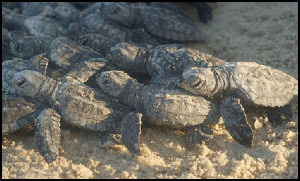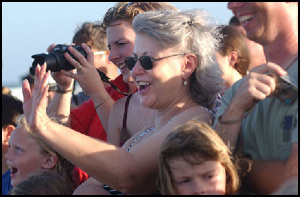 |
 |
 |
 Travel & Outdoors | July 2006 Travel & Outdoors | July 2006  
One Hatchling at a Time
 Kevin Sieff - Brownsville Herald Kevin Sieff - Brownsville Herald


| | 
| | 
| | Endangered sea turtle unites people from different walks of life. |
Tepehuaje, Mexico — The Gulf of Mexico comes to life when the sun sets over the beach of this sleepy coastal town north of Tampico.

Thousands of newborn Kemp’s ridley turtles crawl and squirm their way into the sea every night between May and August.

It’s a rough homecoming, as their tiny, one-inch bodies meet the gulf’s frothy ebb. They are thrown onto their backs, tossed about by waves and hunted by pelicans flying just overhead.

Twenty years ago, this difficult journey — made more difficult, many experts say, by the threats of human harvesting and shrimp trawls — almost brought the Kemp’s ridley to extinction.

Today, the number of Kemp’s ridley sea turtle nests have rebounded to more than 10,000, mainly due to conversation efforts by different organizations and environmentalists. Though the turtle continues to be on endangered species lists, conservationists believe the turtle will be upgraded to threatened in the next few years.

Perhaps no one cares more about the species’ success than Jaime Ortiz, the director of the Tepehuaje camp, which is about 80 miles north of Tampico. As a native of Tepehuaje, Ortiz knows how important the turtle is to the local population.

“This is the only place in the world where the turtle lives,” he said. “It is our responsibility to take care of it.”

Local workers are the muscle of the Kemp’s ridley project. They often work 20-hour days, scanning the beaches for nests during the afternoon and releasing newly hatched turtles until dawn.

In 1986, only 702 nests were found on the Tamaulipas coastline, where the vast majority of female ridleys lay their eggs. This made the species one of the most endangered turtles on the planet.

Those nesting numbers were especially disheartening for scientists in light of the turtle’s prolific past. A 1947 film estimated 40,000 females nesting on the Tamaulipas coast on a single day.

Two sources are often pointed to for the population decline: the human harvesting of turtle eggs, which was largely solved in the mid-60s when the Mexican government sent its navy to protect turtle nesting areas, and shrimp trawls, which has been a more complicated issue to deal with.

Because female Kemp’s ridley turtles divide their time between American and Mexican waters, any solution would have had to have been multilateral. As the campaign has evolved, this multilateralism has made for several seemingly unlikely bedfellows.

Les and Larry Hodgson have co-owned Brownsville-based Marco Sales, a shrimp importer, processor and distributor, for 30 years. Because shrimp trawls were considered the greatest challenge to turtle conservation, the brothers’ company was held partially responsible for the species’ floundering numbers.

“We thought we were being unfairly blamed for the demise of the turtle, but we didn’t know enough about the situation to be sure,” Les Hodgson said.

In the early 1990s, the federal government forced shrimp companies to equip their fleets with Turtle Excluding Devices (TEDs) which would allow the Kemp’s ridley, the world’s smallest sea turtle, to escape from shrimp trawls, but for Les and Larry Hodgson, adherence to environmental law was not enough.

After doing some research, they found that while TEDs were a step in the right direction, the real problem was on beach, where unprotected eggs were heavily preyed on by animals.

The Hodgons began pressing the issue to environmental organizations in the U.S., like the U.S. Fish and Wildlife Service and the Texas Parks and Wildlife Department. Throughout the last decade, their support, along with the help of zoologist Dr. Patrick Burchfield, deputy director of the Gladys Porter Zoo, galvanized the American contribution to the Kemp’s ridley conservation project.

“They’re spending a lot of personal time and personal wealth there,” said Mike Ray, deputy director for management resources for the Texas Parks and Wildlife Department’s coastal fisheries division. “I’ve never heard of a conservation effort like this in which private companies and government departments work so closely.”

Ray’s participation is a perfect example of this symbiosis: He joined the project only after Les Hodgson’s persistent requests.

By 1996, Marco Sales, along with several other seafood companies, began working with the Mexican shrimp industry to set up more turtle camps along the coast of Tamaulipas. Among the projects that they helped to set up is the Tepehuaje camp.

“This kind of project should be the prototype for the conservation of any species,” Larry Hodgson said. “It combines government organizations, private organizations and environmental groups — all from two different countries.”

While conservation projects have historically pit private industry and environmentalists against each other, the Kemp’s ridley project has created a rare cooperation between the groups.

“For us,” said Eddie Gordon, president of Wild American Shrimp in Charleston, S.C., “it’s important to put a face on the shrimper, to show that shrimpers can and are doing something to save the turtles.”

For Gordon, conservation is not only noble, it’s marketable. Wild American Shrimp’s Web site proudly tells of the nonprofit corporation’s participation in the Kemp’s ridley project as a part of its “Our Story” section.

“Educated consumers have a choice,” Gordon said. “We hope they will choose the environmentally friendly product.”

Wild American’s biggest competition comes from aquaculture, or shrimp farming, companies, which are often blamed for destroying biodiversity by transmitting diseases and reducing genetic variability. In this respect, environmental consciousness has become a means of product differentiation for Wild American Shrimp.

Although the conservation project was founded by the Mexican government in 1966, the project has seen its greatest success in the last decade. Between 1995 and 2005, the number of Kemp’s ridley nests have more than quintupled, reaching 11,000 nests and 630,700 hatchlings.

Although the Kemp’s ridley turtle is still on endangered species lists, many scientists predict that the species will be downlisted to threatened within the next six years.

For Steve Labuda, U.S.-Mexico coordinator for the South Texas Refuge Complex for the U.S. Fish and Wildlife Service, this implies more than the success of just one species of sea turtle.

“Because the Kemp’s ridley is a keystone species, their survival is necessary to the entire ecosystem of which they are a part,” he said.

Labuda’s rhetoric is familiar to the Hodgson brothers. If a keystone species reaches extinction in the Gulf of Mexico, it could have dire consequences for the shrimp industry.

“On one level, it’s important that the turtle survives because it is a part of the healthy marine environment on which our industry relies,” Larry Hodgson said.

At home in Texas, the Hodgsons, Ray, Gordon and Labuda, have different careers and backgrounds in conservation, but on the stretch of the Mexican coast where the Kemp’s ridley makes its home, they’re each just another pair of hands, another vehicle used to bring an inch-long baby turtle to its new home in the gulf.

Experts are hoping that the Kemp’s ridley project will mark the beginning of a new era of conservation. If the era needs a poster child, Les Hodgson might be the right man for the job. His face lights up as soon as the Kemp’s ridley becomes a topic of conversation.

“How many people in their lifetimes get a chance to save a species that they thought was gone?” Hodgson said. “It makes you feel good.”

ksieff@brownsvilleherald.com | 
 | |
 |



